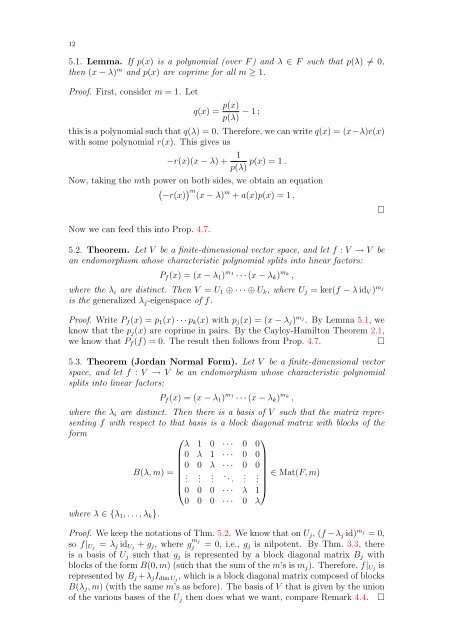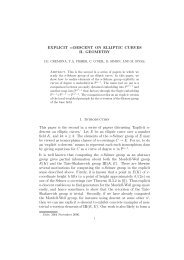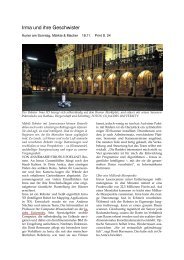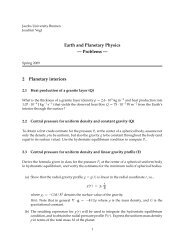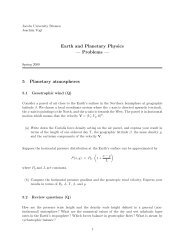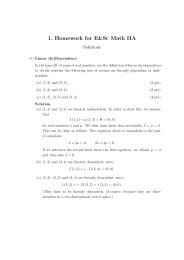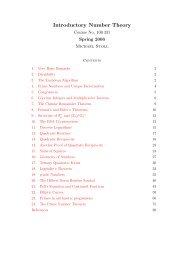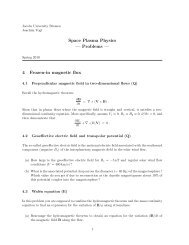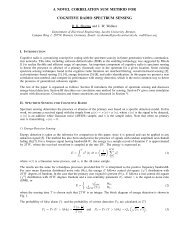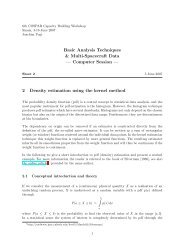Linear Algebra II (pdf, 500 kB)
Linear Algebra II (pdf, 500 kB)
Linear Algebra II (pdf, 500 kB)
Create successful ePaper yourself
Turn your PDF publications into a flip-book with our unique Google optimized e-Paper software.
12<br />
5.1. Lemma. If p(x) is a polynomial (over F ) and λ ∈ F such that p(λ) = 0,<br />
then (x − λ) m and p(x) are coprime for all m ≥ 1.<br />
Proof. First, consider m = 1. Let<br />
q(x) = p(x)<br />
− 1 ;<br />
p(λ)<br />
this is a polynomial such that q(λ) = 0. Therefore, we can write q(x) = (x−λ)r(x)<br />
with some polynomial r(x). This gives us<br />
−r(x)(x − λ) + 1<br />
p(x) = 1 .<br />
p(λ)<br />
Now, taking the mth power on both sides, we obtain an equation<br />
−r(x) m(x − λ) m + a(x)p(x) = 1 .<br />
Now we can feed this into Prop. 4.7.<br />
5.2. Theorem. Let V be a finite-dimensional vector space, and let f : V → V be<br />
an endomorphism whose characteristic polynomial splits into linear factors:<br />
Pf(x) = (x − λ1) m1 · · · (x − λk) mk ,<br />
where the λi are distinct. Then V = U1 ⊕ · · · ⊕ Uk, where Uj = ker(f − λ idV ) mj<br />
is the generalized λj-eigenspace of f.<br />
Proof. Write Pf(x) = p1(x) · · · pk(x) with pj(x) = (x − λj) mj . By Lemma 5.1, we<br />
know that the pj(x) are coprime in pairs. By the Cayley-Hamilton Theorem 2.1,<br />
we know that Pf(f) = 0. The result then follows from Prop. 4.7. <br />
5.3. Theorem (Jordan Normal Form). Let V be a finite-dimensional vector<br />
space, and let f : V → V be an endomorphism whose characteristic polynomial<br />
splits into linear factors:<br />
Pf(x) = (x − λ1) m1 · · · (x − λk) mk ,<br />
where the λi are distinct. Then there is a basis of V such that the matrix representing<br />
f with respect to that basis is a block diagonal matrix with blocks of the<br />
form<br />
⎛<br />
λ 1 0 · · · 0<br />
⎞<br />
0<br />
⎜0<br />
⎜<br />
⎜0<br />
B(λ, m) = ⎜ .<br />
⎝0<br />
λ<br />
0<br />
.<br />
0<br />
1<br />
λ<br />
.<br />
0<br />
· · ·<br />
· · ·<br />
...<br />
· · ·<br />
0<br />
0<br />
.<br />
λ<br />
0 ⎟<br />
0 ⎟<br />
.<br />
⎟ ∈ Mat(F, m)<br />
⎟<br />
1⎠<br />
0 0 0 · · · 0 λ<br />
where λ ∈ {λ1, . . . , λk}.<br />
Proof. We keep the notations of Thm. 5.2. We know that on Uj, (f −λj id) mj = 0,<br />
so f|Uj = λj idUj + gj, where g mj<br />
j = 0, i.e., gj is nilpotent. By Thm. 3.3, there<br />
is a basis of Uj such that gj is represented by a block diagonal matrix Bj with<br />
blocks of the form B(0, m) (such that the sum of the m’s is mj). Therefore, f|Uj is<br />
represented by Bj +λjIdim Uj , which is a block diagonal matrix composed of blocks<br />
B(λj, m) (with the same m’s as before). The basis of V that is given by the union<br />
of the various bases of the Uj then does what we want, compare Remark 4.4.


